热门标签
热门文章
- 1Vscode搭建开发调试STM32/RISC-V环境IDE(最全面)_vscode stm32
- 2JavaScript 二进制数组(ArrayBuffer、Typed Array、DataView)_js 二进制数组
- 3【华为OD机试真题 python】最大数字【2023 Q1 | 200分】_最大值 od python
- 4Win10控制面板打不开怎么办?_win10控制面板无法打开
- 5DCT如此重要,作者当初竟然不知道?
- 6阿里云堡垒机搭建_云盾堡垒机ssh非默认端口
- 7扑克类游戏斗地主、蜘蛛纸牌源码_开源纸牌小游戏
- 8Python爬虫基础之 Selenium
- 9如何在CentOS6中写systemctl daemon-reload
- 10Leectcode417太平洋大西洋水流问题_med_C++
当前位置: article > 正文
快速入门:使用 Gemini Embeddings 和 Elasticsearch 进行向量搜索
作者:花生_TL007 | 2024-02-21 21:28:28
赞
踩
快速入门:使用 Gemini Embeddings 和 Elasticsearch 进行向量搜索
Gemini 是 Google DeepMind 开发的多模态大语言模型家族,作为 LaMDA 和 PaLM 2 的后继者。由 Gemini Ultra、Gemini Pro 和 Gemini Nano 组成,于 2023 年 12 月 6 日发布,定位为 OpenAI 的竞争者 GPT-4。
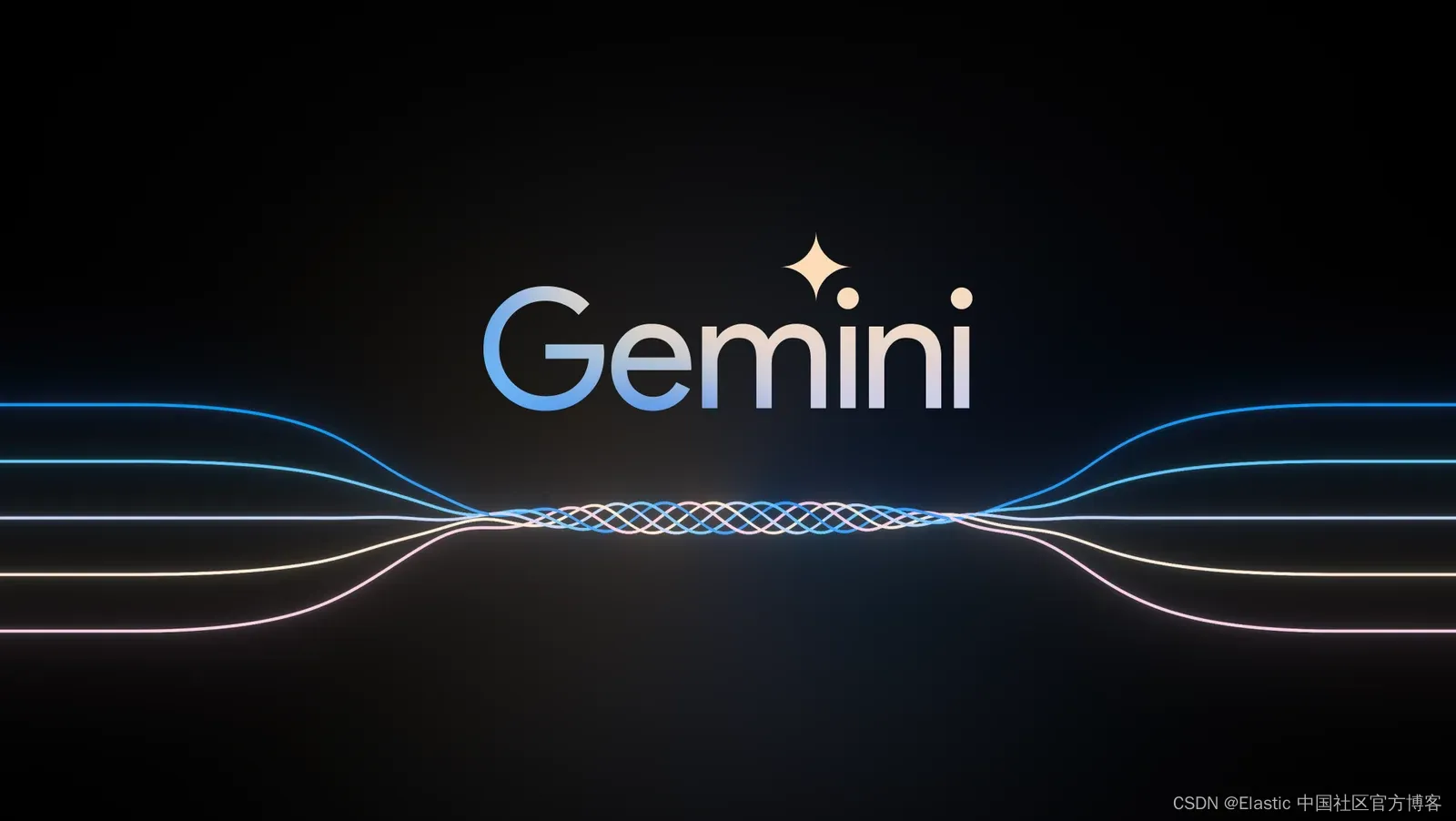
本教程演示如何使用 Gemini API 创建嵌入并将其存储在 Elasticsearch 中。 Elasticsearch 将使我们能够执行向量搜索 (Knn) 来查找相似的文档。
准备
Elasticsearch 及 Kibana
如果你还没有安装好自己的 Elasticsearch 及 Kibana 的话,请参阅如下的文章来进行安装:
在安装的时候,请参照 Elastic Stack 8.x 的文章来进行安装。

Gemini 开发者 key
你可以参考文章 来申请一个免费的 key 供下面的开发。你也可以直接去地址进行申请。
设置环境变量
我们在 termnial 中打入如下的命令来设置环境变量:
- export ES_USER=elastic
- export ES_PASSWORD=-M3aD_m3MHCZNYyJi_V2
- export GOOGLE_API_KEY=YourGoogleAPIkey
拷贝 Elasticsearch 证书
我们把 Elasticsearch 的证书拷贝到当前的目录下:
- $ pwd
- /Users/liuxg/python/elser
- $ cp ~/elastic/elasticsearch-8.12.0/config/certs/http_ca.crt .
安装 Python 依赖包
pip3 install -q -U google-generativeai elasticsearch应用设计
我们在当前的工作目录下打入命令:
jupyter notebook导入包及环境变量
- import google.generativeai as genai
- import google.ai.generativelanguage as glm
- from elasticsearch import Elasticsearch, helpers
- from dotenv import load_dotenv
- import os
-
- load_dotenv()
-
- GOOGLE_API_KEY = os.getenv("GOOGLE_API_KEY")
- ES_USER = os.getenv("ES_USER")
- ES_PASSWORD = os.getenv("ES_PASSWORD")
- elastic_index_name='gemini-demo'
连接到 Elasticsearch
- url = f"https://{ES_USER}:{ES_PASSWORD}@192.168.0.3:9200"
-
- es = Elasticsearch(
- hosts=[url],
- ca_certs = "./http_ca.crt",
- verify_certs = True
- )
- print(es.info())

上面显示我们的 es 连接是成功的。
删除索引
- if(es.indices.exists(index=elastic_index_name)):
- print("The index has already existed, going to remove it")
- es.options(ignore_status=404).indices.delete(index=elastic_index_name)
使用 Elasticsearch 索引文档
生成一个 title 为 “Beijing” 文档:
- genai.configure(api_key=GOOGLE_API_KEY)
-
- title = "Beijing"
- sample_text = ("Beijing is the capital of China and the center of Chinese politics, culture, and economy. This city has a long history with many ancient buildings and cultural heritage. Beijing is renowned as a cultural city in China, boasting numerous museums, art galleries, and historical landmarks. Additionally, as a modern metropolis, Beijing is a thriving business center with modern architecture and advanced transportation systems. It serves as the seat of the Chinese government, where significant decisions and events often take place. Overall, Beijing holds a crucial position in China, serving as both a preserver of traditional culture and a representative of modern development.")
-
- model = 'models/embedding-001'
- embedding = genai.embed_content(model=model,
- content=sample_text,
- task_type="retrieval_document",
- title=title)
-
- doc = {
- 'text' : sample_text,
- 'text_embedding' : embedding['embedding']
- }
-
- resp = es.index(index=elastic_index_name, document=doc)
-
- print(resp)

生成一个 title 为 “Shanghai” 的文档:
- title = "Shanghai"
- sample_text = ("Shanghai is one of China's largest cities and a significant hub for economy, finance, and trade. This modern city is located in the eastern part of China and serves as an international metropolis. The bustling streets, skyscrapers, and modern architecture in Shanghai showcase the city's prosperity and development. As one of China's economic engines, Shanghai is home to the headquarters of many international companies and various financial institutions. It is also a crucial trading port, connecting with destinations worldwide. Additionally, Shanghai boasts a rich cultural scene, including art galleries, theaters, and historical landmarks. In summary, Shanghai is a vibrant, modern city with international influence.")
-
- model = 'models/embedding-001'
- embedding = genai.embed_content(model=model,
- content=sample_text,
- task_type="retrieval_document",
- title=title)
-
- doc = {
- 'text' : sample_text,
- 'text_embedding' : embedding['embedding']
- }
-
- resp = es.index(index=elastic_index_name, document=doc)
-
- print(resp)

我们可以在 Kibana 中进行查看:
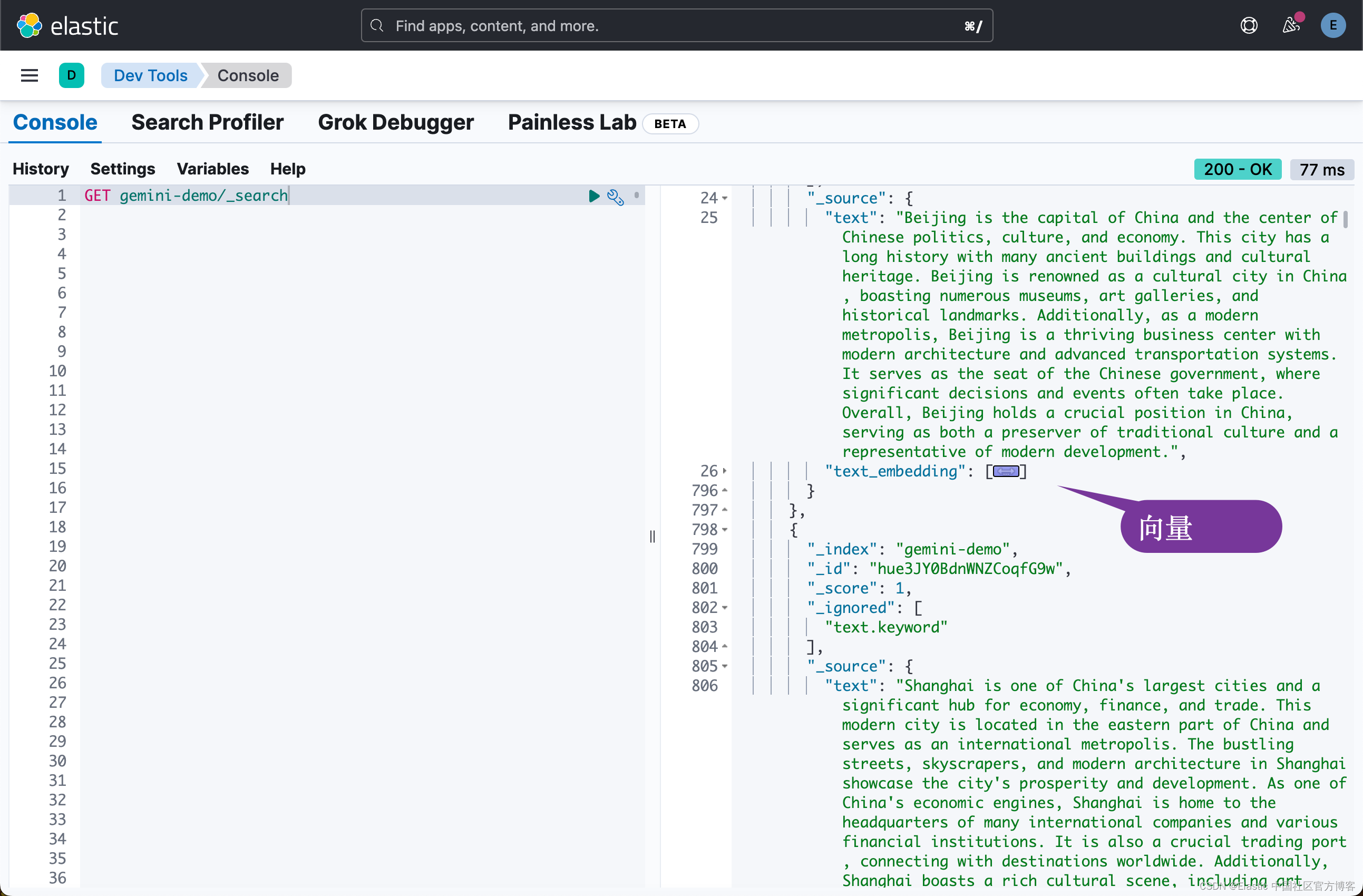
使用 Elasticsearch 来搜索文档
- def search(question):
- print("\n\nQuestion: ", question)
- embedding = genai.embed_content(model=model,
- content=question,
- task_type="retrieval_query")
-
- resp = es.search(
- index = elastic_index_name,
- knn={
- "field": "text_embedding",
- "query_vector": embedding['embedding'],
- "k": 10,
- "num_candidates": 100
- }
- )
-
- for result in resp['hits']['hits']:
- pretty_output = (f"\n\nID: {result['_id']}\n\nText: {result['_source']['text']}")
- print(pretty_output)

search("How do you describe Beijing?")
search("What is Shanghai like?")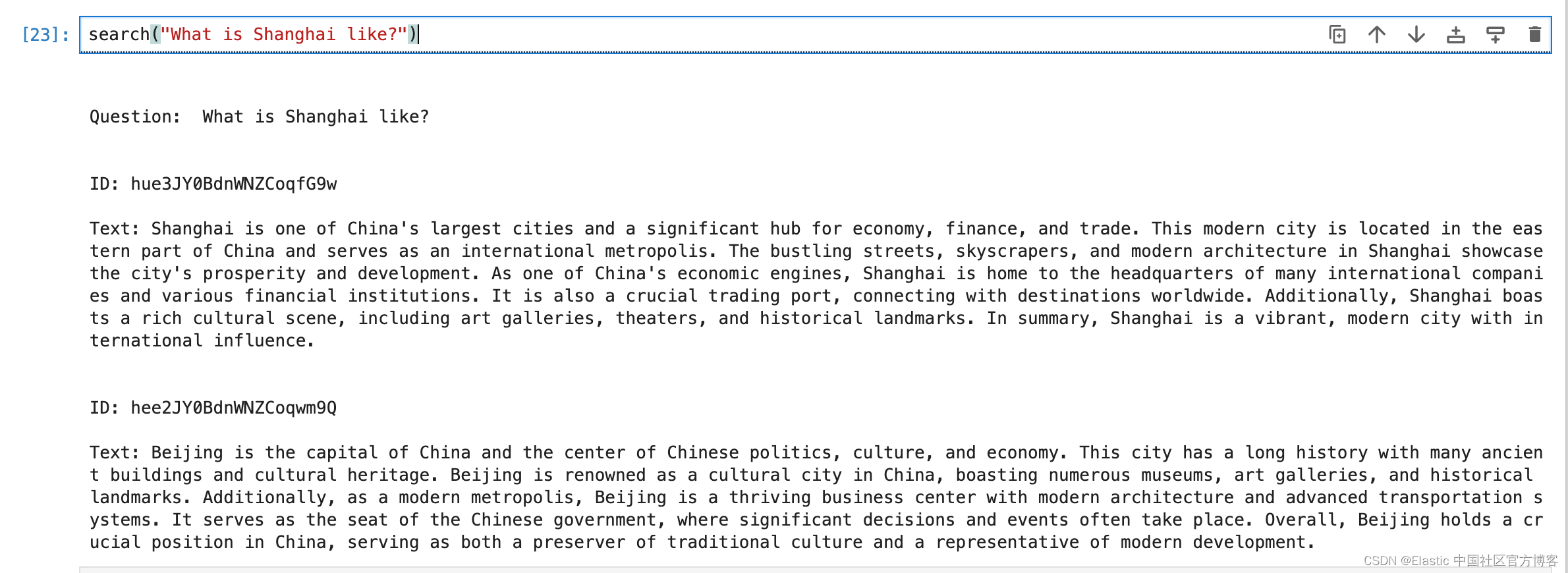
从上面的输出中,我们可以看出来,当搜索的句子和文章更为接近时,相关的文档就会排在第一的位置。紧接着的是次之相关的文档。
search("which city is the capital of China?")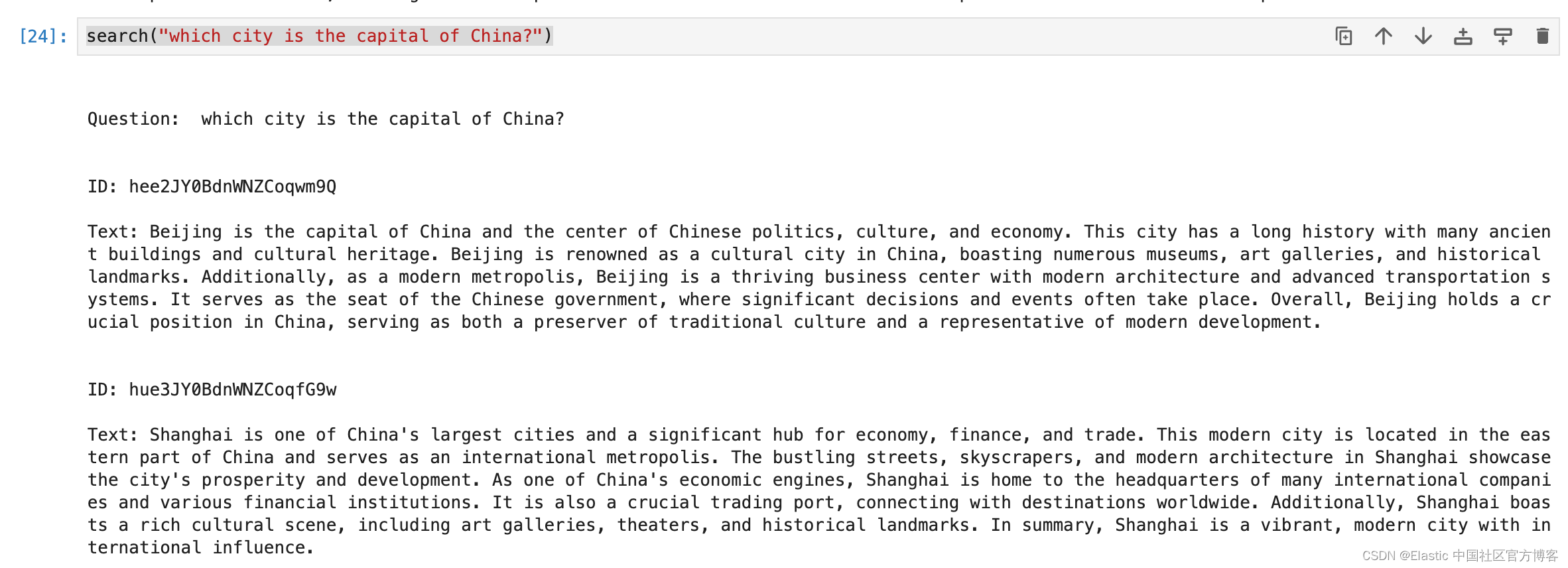
search("the economy engine in China")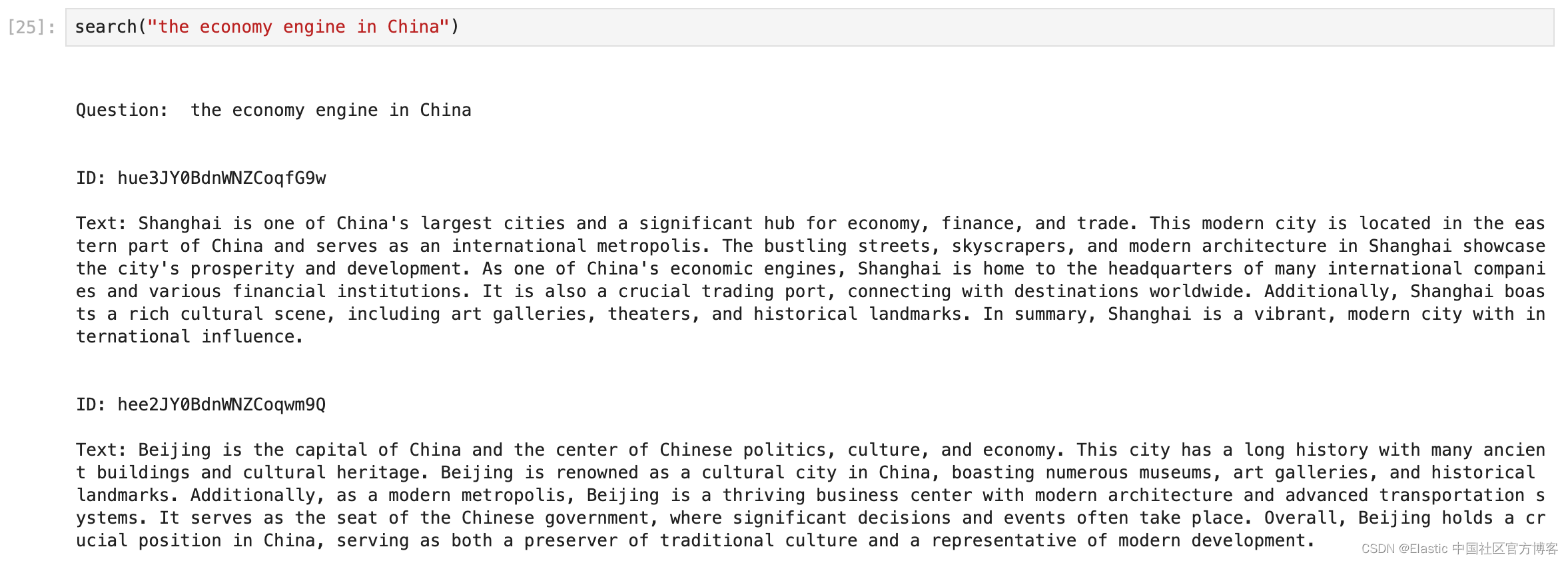
最后,源码在位置可以进行下载:https://github.com/liu-xiao-guo/semantic_search_es/blob/main/vector-search-using-gemini-elastic.ipynb
声明:本文内容由网友自发贡献,不代表【wpsshop博客】立场,版权归原作者所有,本站不承担相应法律责任。如您发现有侵权的内容,请联系我们。转载请注明出处:https://www.wpsshop.cn/w/花生_TL007/article/detail/126682
推荐阅读
相关标签


